Influence of Organizational Culture, Power, and Politics at Napolact
VerifiedAdded on 2022/12/28
|18
|5841
|95
Report
AI Summary
This report delves into the organizational behaviour of Napolact, a major Romanian dairy producer. It examines the influence of organizational culture, power, and politics on individual and team behaviour, and performance. The report analyzes content and process theories of motivation, including Maslow's Hierarchy of Needs, Herzberg's Two-Factor Model, and Vroom's Expectancy Theory, to understand how employees are motivated. It contrasts effective and ineffective team dynamics, highlighting factors that contribute to successful teamwork. Furthermore, the report explores various concepts and philosophies of organizational behaviour, providing a comprehensive understanding of the subject matter within the context of the company. The report aims to provide insights into how Napolact can improve employee performance and foster a collaborative work environment.
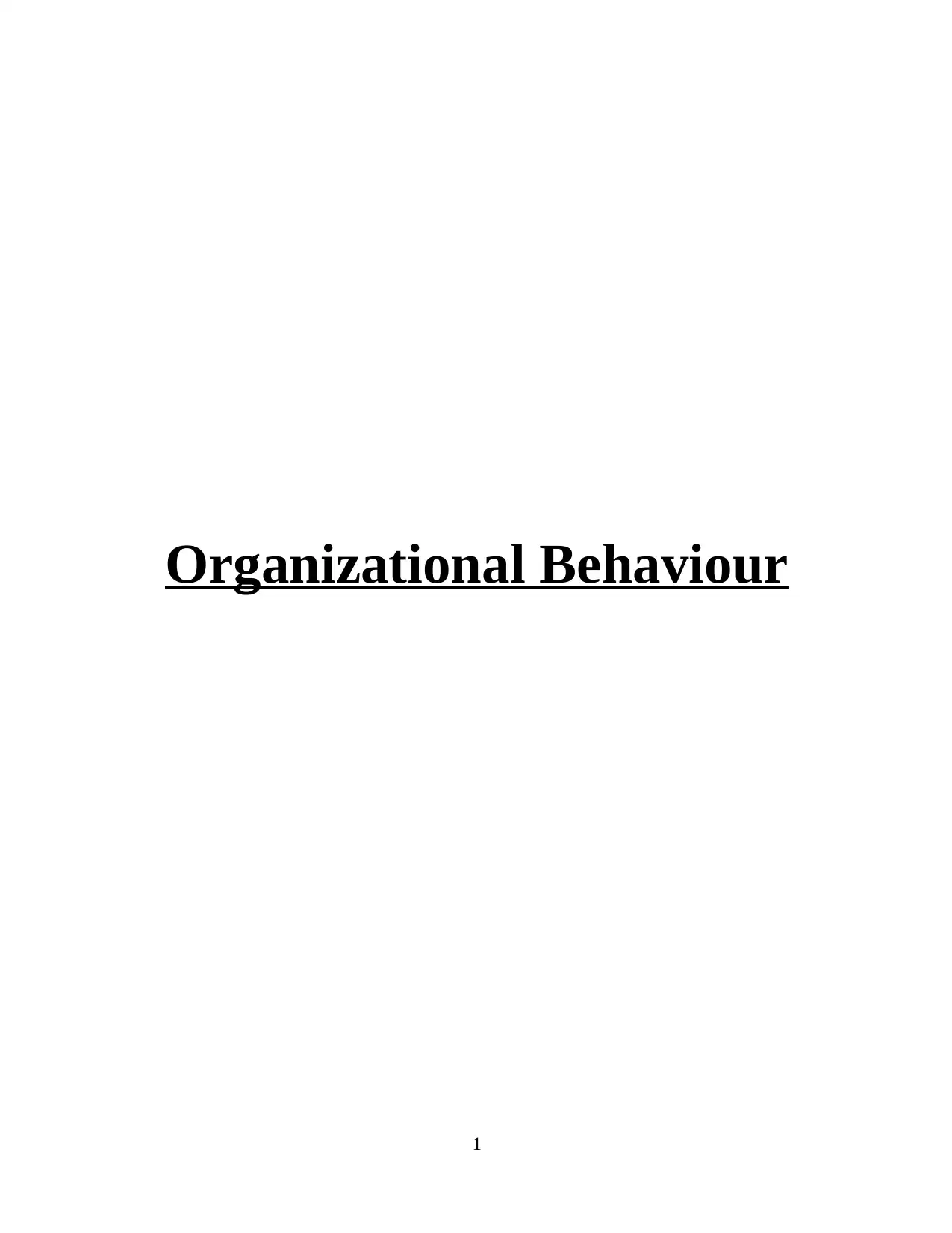
Organizational Behaviour
1
1
Paraphrase This Document
Need a fresh take? Get an instant paraphrase of this document with our AI Paraphraser
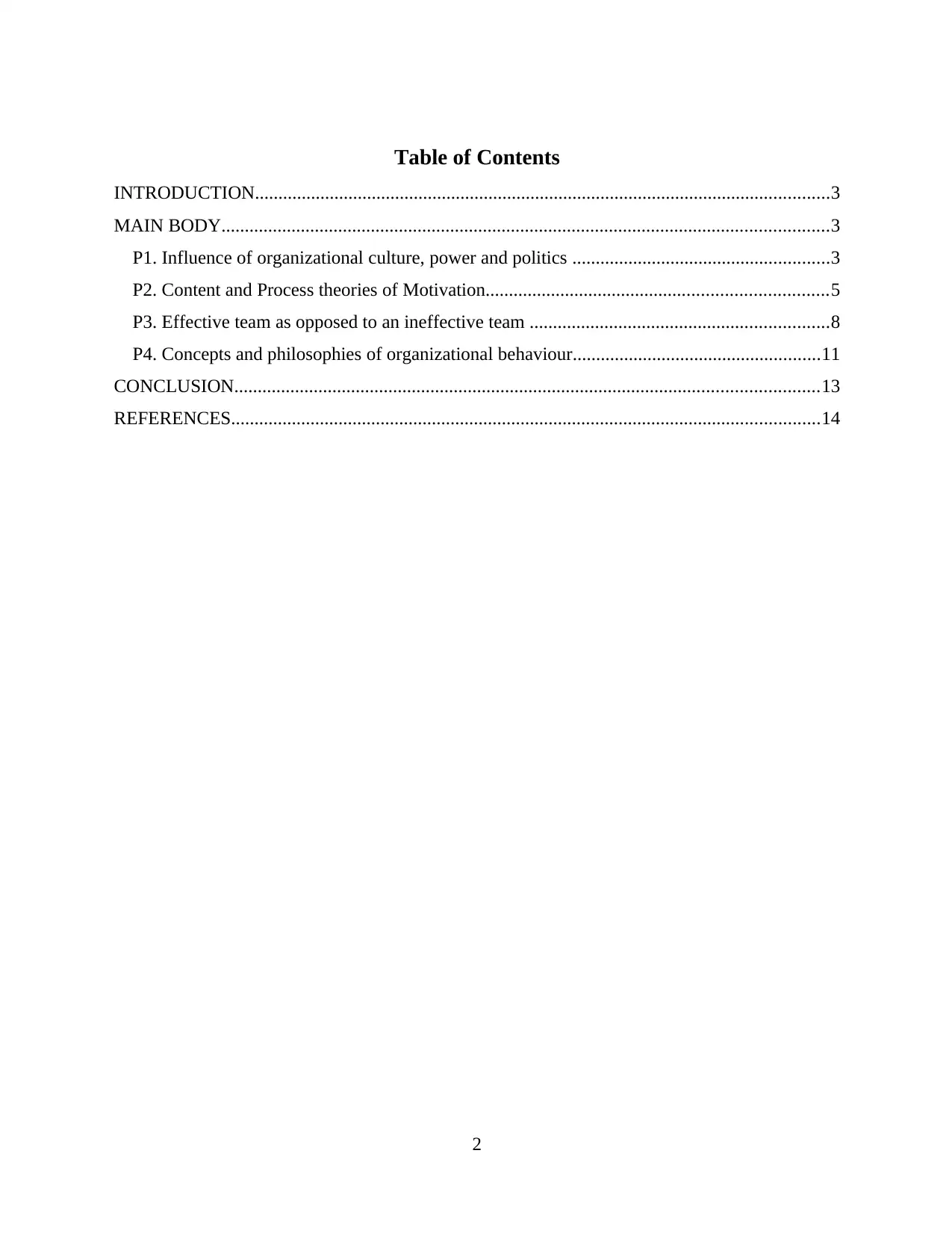
Table of Contents
INTRODUCTION...........................................................................................................................3
MAIN BODY..................................................................................................................................3
P1. Influence of organizational culture, power and politics .......................................................3
P2. Content and Process theories of Motivation.........................................................................5
P3. Effective team as opposed to an ineffective team ................................................................8
P4. Concepts and philosophies of organizational behaviour.....................................................11
CONCLUSION.............................................................................................................................13
REFERENCES..............................................................................................................................14
2
INTRODUCTION...........................................................................................................................3
MAIN BODY..................................................................................................................................3
P1. Influence of organizational culture, power and politics .......................................................3
P2. Content and Process theories of Motivation.........................................................................5
P3. Effective team as opposed to an ineffective team ................................................................8
P4. Concepts and philosophies of organizational behaviour.....................................................11
CONCLUSION.............................................................................................................................13
REFERENCES..............................................................................................................................14
2
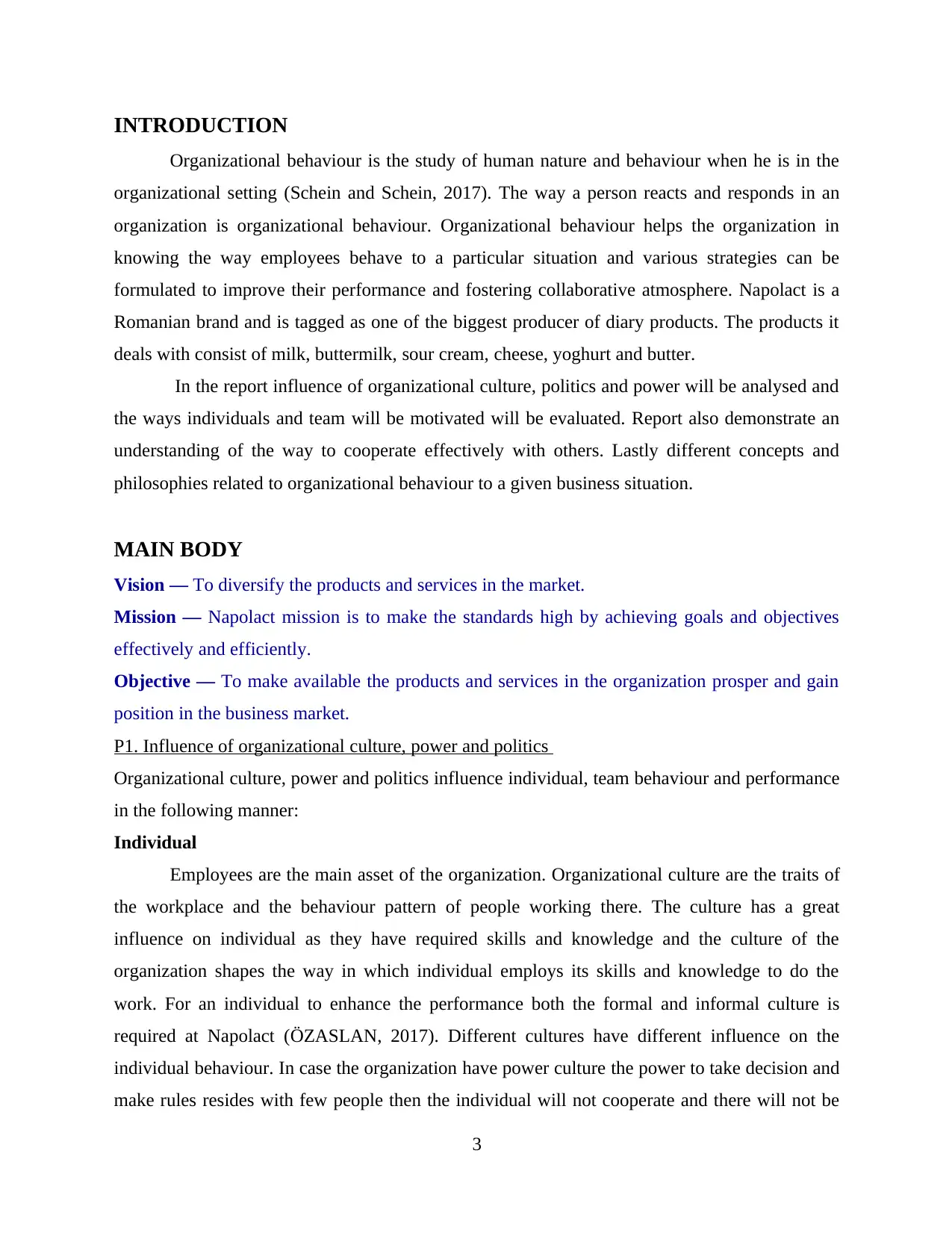
INTRODUCTION
Organizational behaviour is the study of human nature and behaviour when he is in the
organizational setting (Schein and Schein, 2017). The way a person reacts and responds in an
organization is organizational behaviour. Organizational behaviour helps the organization in
knowing the way employees behave to a particular situation and various strategies can be
formulated to improve their performance and fostering collaborative atmosphere. Napolact is a
Romanian brand and is tagged as one of the biggest producer of diary products. The products it
deals with consist of milk, buttermilk, sour cream, cheese, yoghurt and butter.
In the report influence of organizational culture, politics and power will be analysed and
the ways individuals and team will be motivated will be evaluated. Report also demonstrate an
understanding of the way to cooperate effectively with others. Lastly different concepts and
philosophies related to organizational behaviour to a given business situation.
MAIN BODY
Vision — To diversify the products and services in the market.
Mission — Napolact mission is to make the standards high by achieving goals and objectives
effectively and efficiently.
Objective — To make available the products and services in the organization prosper and gain
position in the business market.
P1. Influence of organizational culture, power and politics
Organizational culture, power and politics influence individual, team behaviour and performance
in the following manner:
Individual
Employees are the main asset of the organization. Organizational culture are the traits of
the workplace and the behaviour pattern of people working there. The culture has a great
influence on individual as they have required skills and knowledge and the culture of the
organization shapes the way in which individual employs its skills and knowledge to do the
work. For an individual to enhance the performance both the formal and informal culture is
required at Napolact (ÖZASLAN, 2017). Different cultures have different influence on the
individual behaviour. In case the organization have power culture the power to take decision and
make rules resides with few people then the individual will not cooperate and there will not be
3
Organizational behaviour is the study of human nature and behaviour when he is in the
organizational setting (Schein and Schein, 2017). The way a person reacts and responds in an
organization is organizational behaviour. Organizational behaviour helps the organization in
knowing the way employees behave to a particular situation and various strategies can be
formulated to improve their performance and fostering collaborative atmosphere. Napolact is a
Romanian brand and is tagged as one of the biggest producer of diary products. The products it
deals with consist of milk, buttermilk, sour cream, cheese, yoghurt and butter.
In the report influence of organizational culture, politics and power will be analysed and
the ways individuals and team will be motivated will be evaluated. Report also demonstrate an
understanding of the way to cooperate effectively with others. Lastly different concepts and
philosophies related to organizational behaviour to a given business situation.
MAIN BODY
Vision — To diversify the products and services in the market.
Mission — Napolact mission is to make the standards high by achieving goals and objectives
effectively and efficiently.
Objective — To make available the products and services in the organization prosper and gain
position in the business market.
P1. Influence of organizational culture, power and politics
Organizational culture, power and politics influence individual, team behaviour and performance
in the following manner:
Individual
Employees are the main asset of the organization. Organizational culture are the traits of
the workplace and the behaviour pattern of people working there. The culture has a great
influence on individual as they have required skills and knowledge and the culture of the
organization shapes the way in which individual employs its skills and knowledge to do the
work. For an individual to enhance the performance both the formal and informal culture is
required at Napolact (ÖZASLAN, 2017). Different cultures have different influence on the
individual behaviour. In case the organization have power culture the power to take decision and
make rules resides with few people then the individual will not cooperate and there will not be
3
⊘ This is a preview!⊘
Do you want full access?
Subscribe today to unlock all pages.

Trusted by 1+ million students worldwide
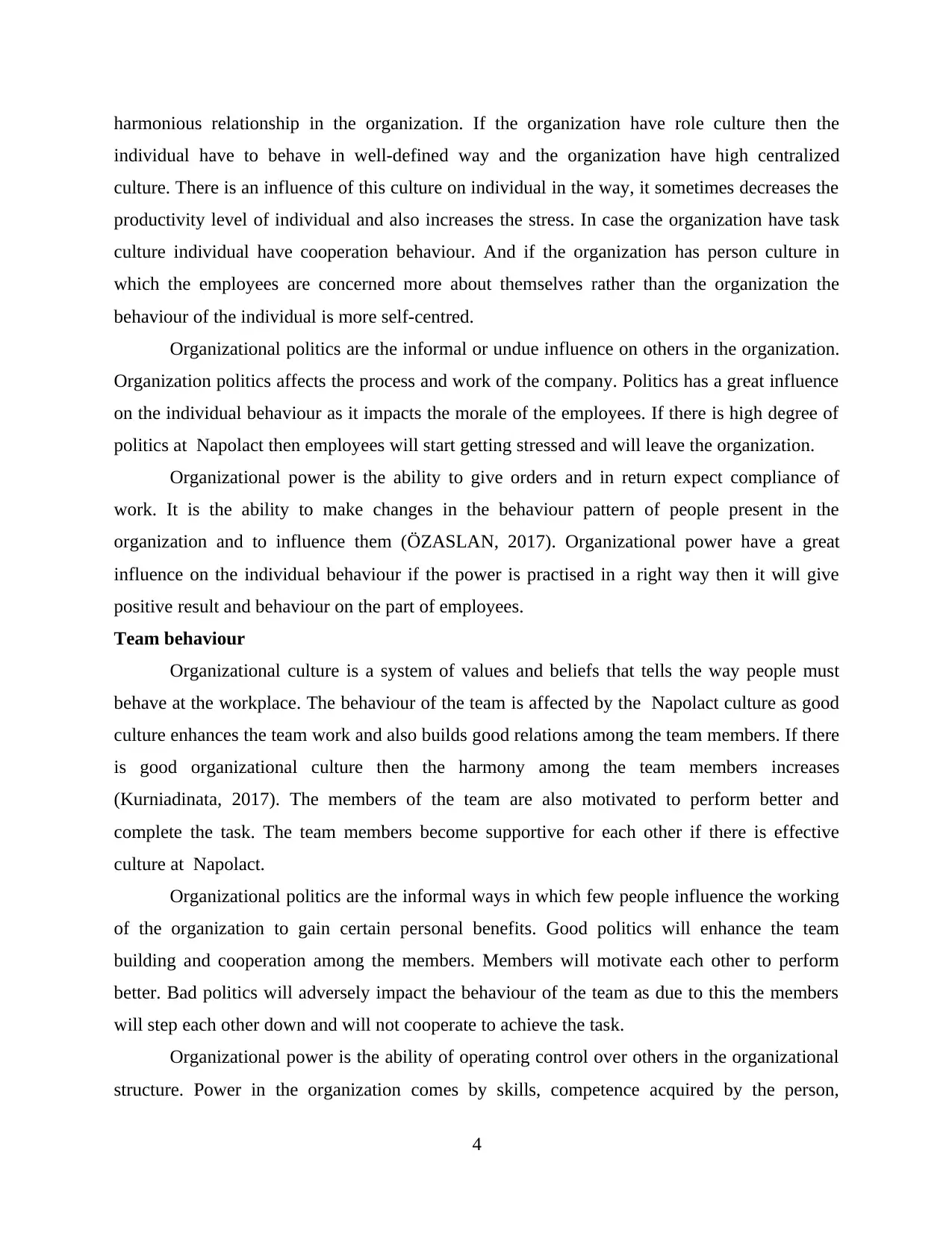
harmonious relationship in the organization. If the organization have role culture then the
individual have to behave in well-defined way and the organization have high centralized
culture. There is an influence of this culture on individual in the way, it sometimes decreases the
productivity level of individual and also increases the stress. In case the organization have task
culture individual have cooperation behaviour. And if the organization has person culture in
which the employees are concerned more about themselves rather than the organization the
behaviour of the individual is more self-centred.
Organizational politics are the informal or undue influence on others in the organization.
Organization politics affects the process and work of the company. Politics has a great influence
on the individual behaviour as it impacts the morale of the employees. If there is high degree of
politics at Napolact then employees will start getting stressed and will leave the organization.
Organizational power is the ability to give orders and in return expect compliance of
work. It is the ability to make changes in the behaviour pattern of people present in the
organization and to influence them (ÖZASLAN, 2017). Organizational power have a great
influence on the individual behaviour if the power is practised in a right way then it will give
positive result and behaviour on the part of employees.
Team behaviour
Organizational culture is a system of values and beliefs that tells the way people must
behave at the workplace. The behaviour of the team is affected by the Napolact culture as good
culture enhances the team work and also builds good relations among the team members. If there
is good organizational culture then the harmony among the team members increases
(Kurniadinata, 2017). The members of the team are also motivated to perform better and
complete the task. The team members become supportive for each other if there is effective
culture at Napolact.
Organizational politics are the informal ways in which few people influence the working
of the organization to gain certain personal benefits. Good politics will enhance the team
building and cooperation among the members. Members will motivate each other to perform
better. Bad politics will adversely impact the behaviour of the team as due to this the members
will step each other down and will not cooperate to achieve the task.
Organizational power is the ability of operating control over others in the organizational
structure. Power in the organization comes by skills, competence acquired by the person,
4
individual have to behave in well-defined way and the organization have high centralized
culture. There is an influence of this culture on individual in the way, it sometimes decreases the
productivity level of individual and also increases the stress. In case the organization have task
culture individual have cooperation behaviour. And if the organization has person culture in
which the employees are concerned more about themselves rather than the organization the
behaviour of the individual is more self-centred.
Organizational politics are the informal or undue influence on others in the organization.
Organization politics affects the process and work of the company. Politics has a great influence
on the individual behaviour as it impacts the morale of the employees. If there is high degree of
politics at Napolact then employees will start getting stressed and will leave the organization.
Organizational power is the ability to give orders and in return expect compliance of
work. It is the ability to make changes in the behaviour pattern of people present in the
organization and to influence them (ÖZASLAN, 2017). Organizational power have a great
influence on the individual behaviour if the power is practised in a right way then it will give
positive result and behaviour on the part of employees.
Team behaviour
Organizational culture is a system of values and beliefs that tells the way people must
behave at the workplace. The behaviour of the team is affected by the Napolact culture as good
culture enhances the team work and also builds good relations among the team members. If there
is good organizational culture then the harmony among the team members increases
(Kurniadinata, 2017). The members of the team are also motivated to perform better and
complete the task. The team members become supportive for each other if there is effective
culture at Napolact.
Organizational politics are the informal ways in which few people influence the working
of the organization to gain certain personal benefits. Good politics will enhance the team
building and cooperation among the members. Members will motivate each other to perform
better. Bad politics will adversely impact the behaviour of the team as due to this the members
will step each other down and will not cooperate to achieve the task.
Organizational power is the ability of operating control over others in the organizational
structure. Power in the organization comes by skills, competence acquired by the person,
4
Paraphrase This Document
Need a fresh take? Get an instant paraphrase of this document with our AI Paraphraser
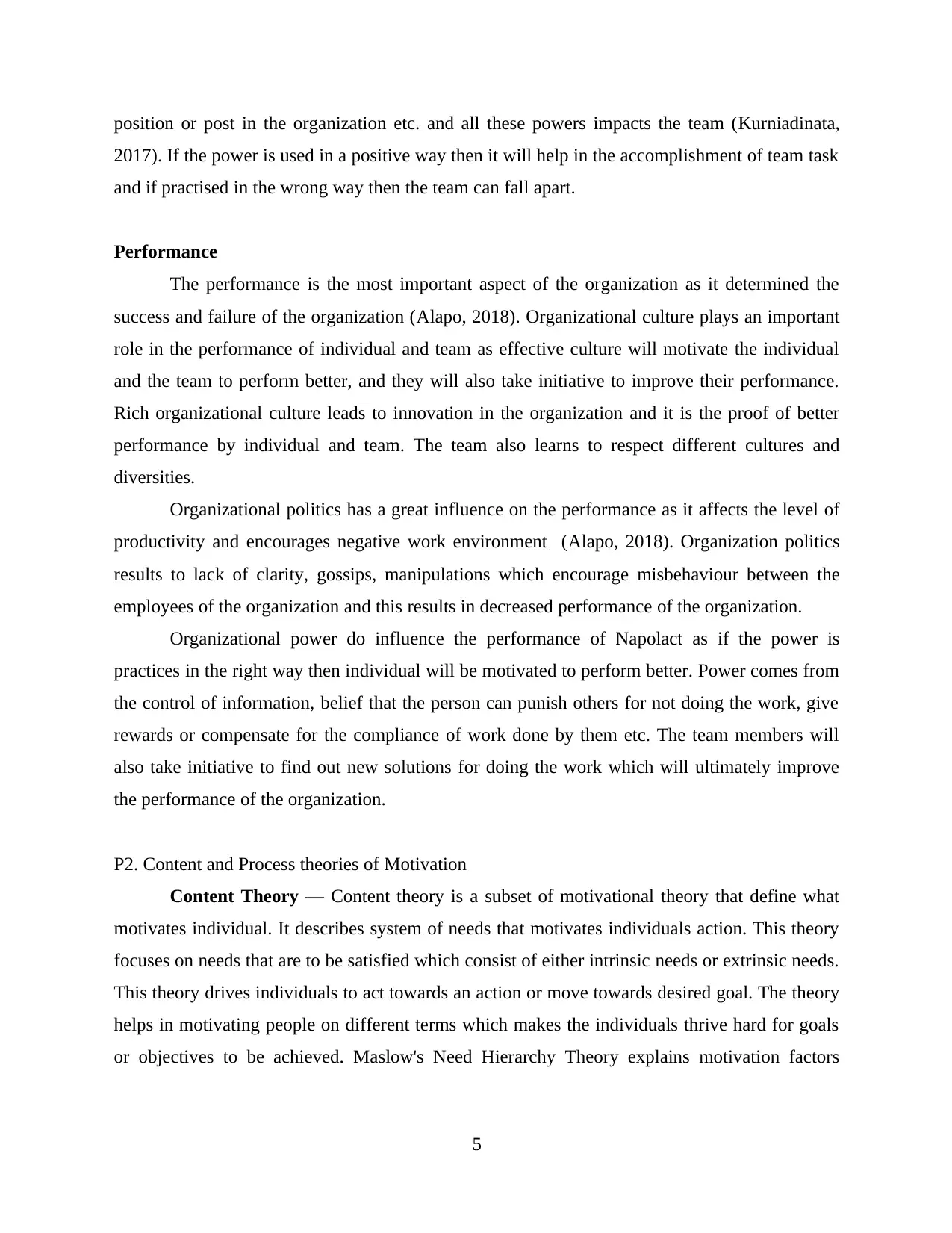
position or post in the organization etc. and all these powers impacts the team (Kurniadinata,
2017). If the power is used in a positive way then it will help in the accomplishment of team task
and if practised in the wrong way then the team can fall apart.
Performance
The performance is the most important aspect of the organization as it determined the
success and failure of the organization (Alapo, 2018). Organizational culture plays an important
role in the performance of individual and team as effective culture will motivate the individual
and the team to perform better, and they will also take initiative to improve their performance.
Rich organizational culture leads to innovation in the organization and it is the proof of better
performance by individual and team. The team also learns to respect different cultures and
diversities.
Organizational politics has a great influence on the performance as it affects the level of
productivity and encourages negative work environment (Alapo, 2018). Organization politics
results to lack of clarity, gossips, manipulations which encourage misbehaviour between the
employees of the organization and this results in decreased performance of the organization.
Organizational power do influence the performance of Napolact as if the power is
practices in the right way then individual will be motivated to perform better. Power comes from
the control of information, belief that the person can punish others for not doing the work, give
rewards or compensate for the compliance of work done by them etc. The team members will
also take initiative to find out new solutions for doing the work which will ultimately improve
the performance of the organization.
P2. Content and Process theories of Motivation
Content Theory — Content theory is a subset of motivational theory that define what
motivates individual. It describes system of needs that motivates individuals action. This theory
focuses on needs that are to be satisfied which consist of either intrinsic needs or extrinsic needs.
This theory drives individuals to act towards an action or move towards desired goal. The theory
helps in motivating people on different terms which makes the individuals thrive hard for goals
or objectives to be achieved. Maslow's Need Hierarchy Theory explains motivation factors
5
2017). If the power is used in a positive way then it will help in the accomplishment of team task
and if practised in the wrong way then the team can fall apart.
Performance
The performance is the most important aspect of the organization as it determined the
success and failure of the organization (Alapo, 2018). Organizational culture plays an important
role in the performance of individual and team as effective culture will motivate the individual
and the team to perform better, and they will also take initiative to improve their performance.
Rich organizational culture leads to innovation in the organization and it is the proof of better
performance by individual and team. The team also learns to respect different cultures and
diversities.
Organizational politics has a great influence on the performance as it affects the level of
productivity and encourages negative work environment (Alapo, 2018). Organization politics
results to lack of clarity, gossips, manipulations which encourage misbehaviour between the
employees of the organization and this results in decreased performance of the organization.
Organizational power do influence the performance of Napolact as if the power is
practices in the right way then individual will be motivated to perform better. Power comes from
the control of information, belief that the person can punish others for not doing the work, give
rewards or compensate for the compliance of work done by them etc. The team members will
also take initiative to find out new solutions for doing the work which will ultimately improve
the performance of the organization.
P2. Content and Process theories of Motivation
Content Theory — Content theory is a subset of motivational theory that define what
motivates individual. It describes system of needs that motivates individuals action. This theory
focuses on needs that are to be satisfied which consist of either intrinsic needs or extrinsic needs.
This theory drives individuals to act towards an action or move towards desired goal. The theory
helps in motivating people on different terms which makes the individuals thrive hard for goals
or objectives to be achieved. Maslow's Need Hierarchy Theory explains motivation factors
5
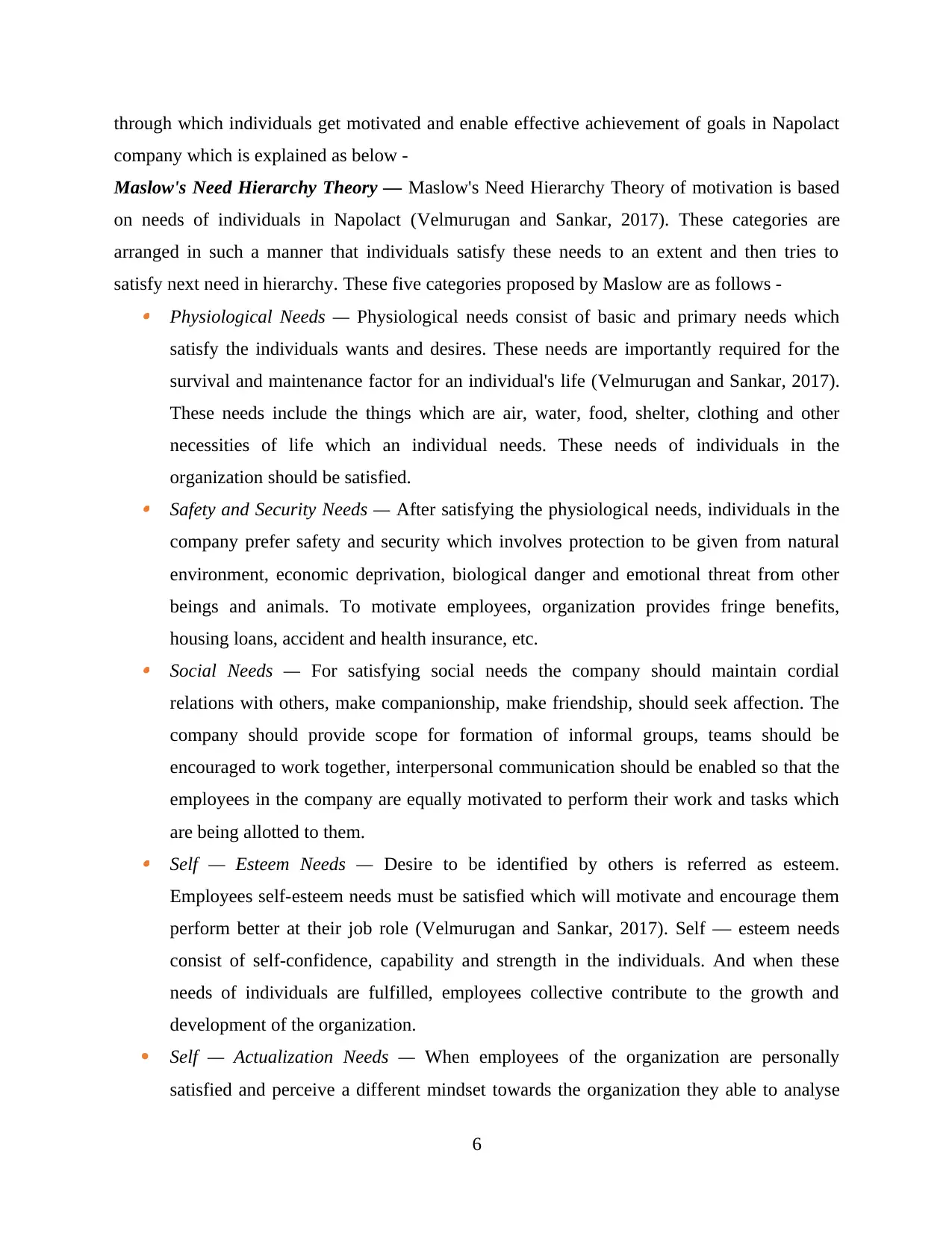
through which individuals get motivated and enable effective achievement of goals in Napolact
company which is explained as below -
Maslow's Need Hierarchy Theory — Maslow's Need Hierarchy Theory of motivation is based
on needs of individuals in Napolact (Velmurugan and Sankar, 2017). These categories are
arranged in such a manner that individuals satisfy these needs to an extent and then tries to
satisfy next need in hierarchy. These five categories proposed by Maslow are as follows - Physiological Needs — Physiological needs consist of basic and primary needs which
satisfy the individuals wants and desires. These needs are importantly required for the
survival and maintenance factor for an individual's life (Velmurugan and Sankar, 2017).
These needs include the things which are air, water, food, shelter, clothing and other
necessities of life which an individual needs. These needs of individuals in the
organization should be satisfied. Safety and Security Needs — After satisfying the physiological needs, individuals in the
company prefer safety and security which involves protection to be given from natural
environment, economic deprivation, biological danger and emotional threat from other
beings and animals. To motivate employees, organization provides fringe benefits,
housing loans, accident and health insurance, etc. Social Needs — For satisfying social needs the company should maintain cordial
relations with others, make companionship, make friendship, should seek affection. The
company should provide scope for formation of informal groups, teams should be
encouraged to work together, interpersonal communication should be enabled so that the
employees in the company are equally motivated to perform their work and tasks which
are being allotted to them. Self — Esteem Needs — Desire to be identified by others is referred as esteem.
Employees self-esteem needs must be satisfied which will motivate and encourage them
perform better at their job role (Velmurugan and Sankar, 2017). Self — esteem needs
consist of self-confidence, capability and strength in the individuals. And when these
needs of individuals are fulfilled, employees collective contribute to the growth and
development of the organization.
Self — Actualization Needs — When employees of the organization are personally
satisfied and perceive a different mindset towards the organization they able to analyse
6
company which is explained as below -
Maslow's Need Hierarchy Theory — Maslow's Need Hierarchy Theory of motivation is based
on needs of individuals in Napolact (Velmurugan and Sankar, 2017). These categories are
arranged in such a manner that individuals satisfy these needs to an extent and then tries to
satisfy next need in hierarchy. These five categories proposed by Maslow are as follows - Physiological Needs — Physiological needs consist of basic and primary needs which
satisfy the individuals wants and desires. These needs are importantly required for the
survival and maintenance factor for an individual's life (Velmurugan and Sankar, 2017).
These needs include the things which are air, water, food, shelter, clothing and other
necessities of life which an individual needs. These needs of individuals in the
organization should be satisfied. Safety and Security Needs — After satisfying the physiological needs, individuals in the
company prefer safety and security which involves protection to be given from natural
environment, economic deprivation, biological danger and emotional threat from other
beings and animals. To motivate employees, organization provides fringe benefits,
housing loans, accident and health insurance, etc. Social Needs — For satisfying social needs the company should maintain cordial
relations with others, make companionship, make friendship, should seek affection. The
company should provide scope for formation of informal groups, teams should be
encouraged to work together, interpersonal communication should be enabled so that the
employees in the company are equally motivated to perform their work and tasks which
are being allotted to them. Self — Esteem Needs — Desire to be identified by others is referred as esteem.
Employees self-esteem needs must be satisfied which will motivate and encourage them
perform better at their job role (Velmurugan and Sankar, 2017). Self — esteem needs
consist of self-confidence, capability and strength in the individuals. And when these
needs of individuals are fulfilled, employees collective contribute to the growth and
development of the organization.
Self — Actualization Needs — When employees of the organization are personally
satisfied and perceive a different mindset towards the organization they able to analyse
6
⊘ This is a preview!⊘
Do you want full access?
Subscribe today to unlock all pages.

Trusted by 1+ million students worldwide
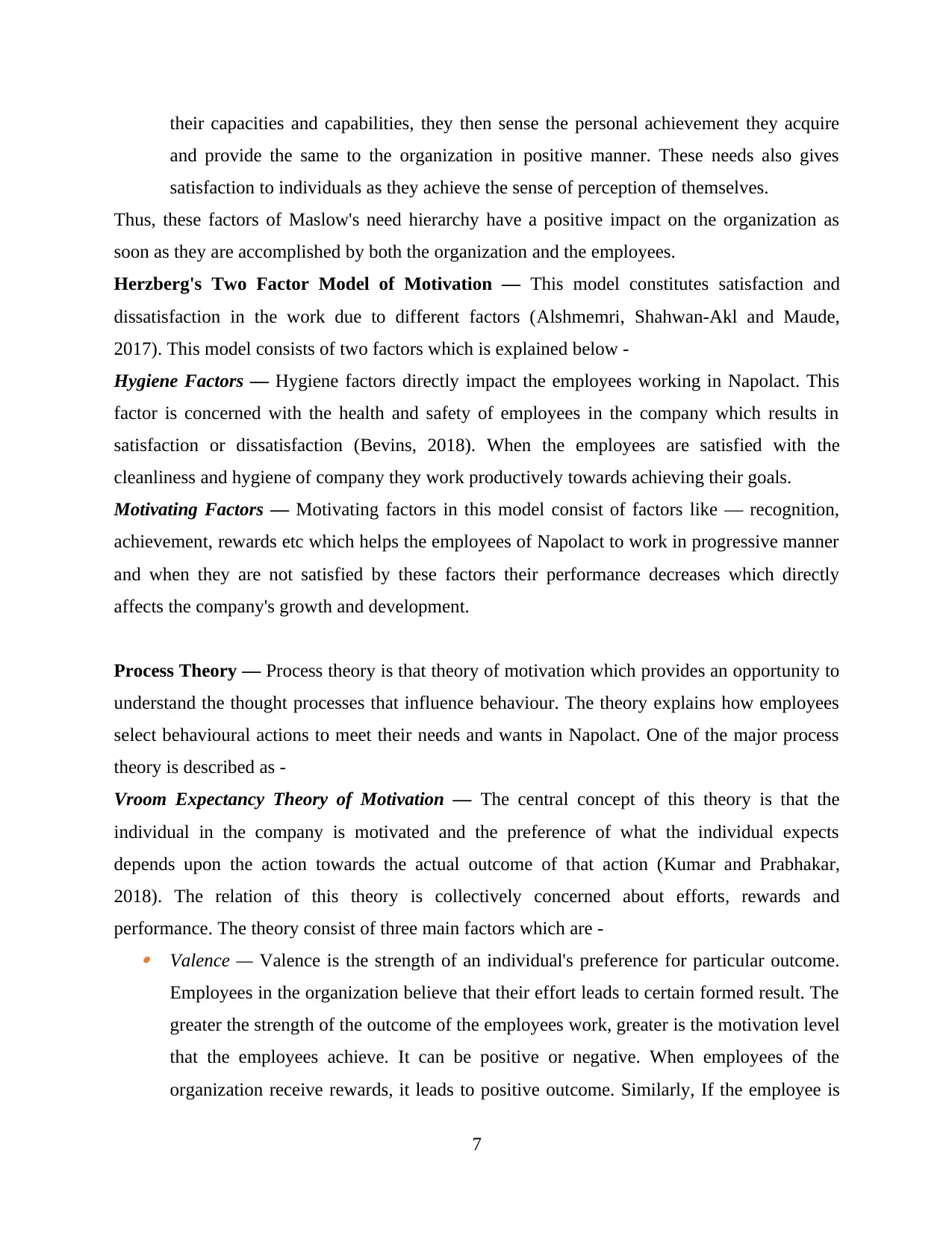
their capacities and capabilities, they then sense the personal achievement they acquire
and provide the same to the organization in positive manner. These needs also gives
satisfaction to individuals as they achieve the sense of perception of themselves.
Thus, these factors of Maslow's need hierarchy have a positive impact on the organization as
soon as they are accomplished by both the organization and the employees.
Herzberg's Two Factor Model of Motivation — This model constitutes satisfaction and
dissatisfaction in the work due to different factors (Alshmemri, Shahwan-Akl and Maude,
2017). This model consists of two factors which is explained below -
Hygiene Factors — Hygiene factors directly impact the employees working in Napolact. This
factor is concerned with the health and safety of employees in the company which results in
satisfaction or dissatisfaction (Bevins, 2018). When the employees are satisfied with the
cleanliness and hygiene of company they work productively towards achieving their goals.
Motivating Factors — Motivating factors in this model consist of factors like — recognition,
achievement, rewards etc which helps the employees of Napolact to work in progressive manner
and when they are not satisfied by these factors their performance decreases which directly
affects the company's growth and development.
Process Theory — Process theory is that theory of motivation which provides an opportunity to
understand the thought processes that influence behaviour. The theory explains how employees
select behavioural actions to meet their needs and wants in Napolact. One of the major process
theory is described as -
Vroom Expectancy Theory of Motivation — The central concept of this theory is that the
individual in the company is motivated and the preference of what the individual expects
depends upon the action towards the actual outcome of that action (Kumar and Prabhakar,
2018). The relation of this theory is collectively concerned about efforts, rewards and
performance. The theory consist of three main factors which are - Valence — Valence is the strength of an individual's preference for particular outcome.
Employees in the organization believe that their effort leads to certain formed result. The
greater the strength of the outcome of the employees work, greater is the motivation level
that the employees achieve. It can be positive or negative. When employees of the
organization receive rewards, it leads to positive outcome. Similarly, If the employee is
7
and provide the same to the organization in positive manner. These needs also gives
satisfaction to individuals as they achieve the sense of perception of themselves.
Thus, these factors of Maslow's need hierarchy have a positive impact on the organization as
soon as they are accomplished by both the organization and the employees.
Herzberg's Two Factor Model of Motivation — This model constitutes satisfaction and
dissatisfaction in the work due to different factors (Alshmemri, Shahwan-Akl and Maude,
2017). This model consists of two factors which is explained below -
Hygiene Factors — Hygiene factors directly impact the employees working in Napolact. This
factor is concerned with the health and safety of employees in the company which results in
satisfaction or dissatisfaction (Bevins, 2018). When the employees are satisfied with the
cleanliness and hygiene of company they work productively towards achieving their goals.
Motivating Factors — Motivating factors in this model consist of factors like — recognition,
achievement, rewards etc which helps the employees of Napolact to work in progressive manner
and when they are not satisfied by these factors their performance decreases which directly
affects the company's growth and development.
Process Theory — Process theory is that theory of motivation which provides an opportunity to
understand the thought processes that influence behaviour. The theory explains how employees
select behavioural actions to meet their needs and wants in Napolact. One of the major process
theory is described as -
Vroom Expectancy Theory of Motivation — The central concept of this theory is that the
individual in the company is motivated and the preference of what the individual expects
depends upon the action towards the actual outcome of that action (Kumar and Prabhakar,
2018). The relation of this theory is collectively concerned about efforts, rewards and
performance. The theory consist of three main factors which are - Valence — Valence is the strength of an individual's preference for particular outcome.
Employees in the organization believe that their effort leads to certain formed result. The
greater the strength of the outcome of the employees work, greater is the motivation level
that the employees achieve. It can be positive or negative. When employees of the
organization receive rewards, it leads to positive outcome. Similarly, If the employee is
7
Paraphrase This Document
Need a fresh take? Get an instant paraphrase of this document with our AI Paraphraser
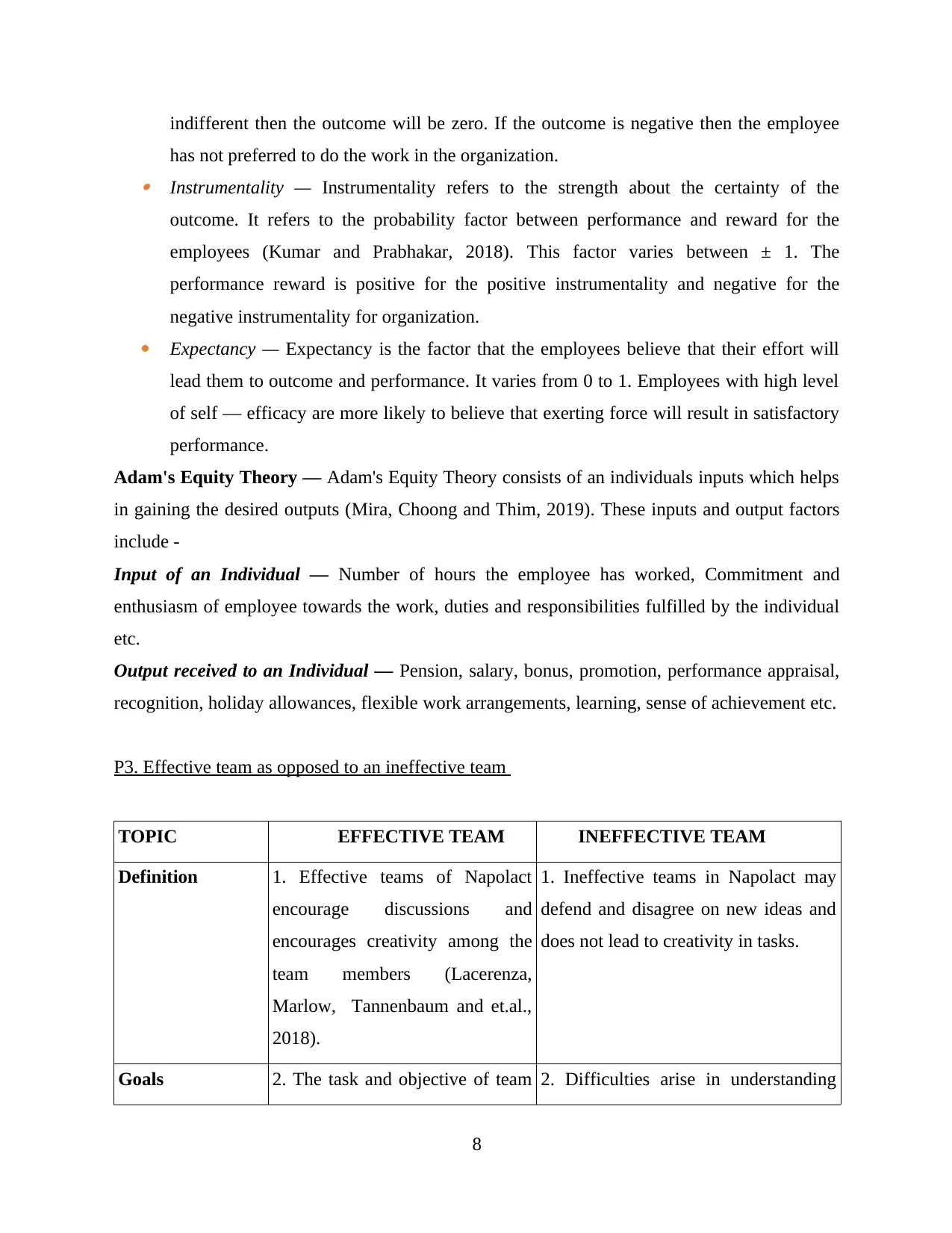
indifferent then the outcome will be zero. If the outcome is negative then the employee
has not preferred to do the work in the organization. Instrumentality — Instrumentality refers to the strength about the certainty of the
outcome. It refers to the probability factor between performance and reward for the
employees (Kumar and Prabhakar, 2018). This factor varies between ± 1. The
performance reward is positive for the positive instrumentality and negative for the
negative instrumentality for organization.
Expectancy — Expectancy is the factor that the employees believe that their effort will
lead them to outcome and performance. It varies from 0 to 1. Employees with high level
of self — efficacy are more likely to believe that exerting force will result in satisfactory
performance.
Adam's Equity Theory — Adam's Equity Theory consists of an individuals inputs which helps
in gaining the desired outputs (Mira, Choong and Thim, 2019). These inputs and output factors
include -
Input of an Individual — Number of hours the employee has worked, Commitment and
enthusiasm of employee towards the work, duties and responsibilities fulfilled by the individual
etc.
Output received to an Individual — Pension, salary, bonus, promotion, performance appraisal,
recognition, holiday allowances, flexible work arrangements, learning, sense of achievement etc.
P3. Effective team as opposed to an ineffective team
TOPIC EFFECTIVE TEAM INEFFECTIVE TEAM
Definition 1. Effective teams of Napolact
encourage discussions and
encourages creativity among the
team members (Lacerenza,
Marlow, Tannenbaum and et.al.,
2018).
1. Ineffective teams in Napolact may
defend and disagree on new ideas and
does not lead to creativity in tasks.
Goals 2. The task and objective of team 2. Difficulties arise in understanding
8
has not preferred to do the work in the organization. Instrumentality — Instrumentality refers to the strength about the certainty of the
outcome. It refers to the probability factor between performance and reward for the
employees (Kumar and Prabhakar, 2018). This factor varies between ± 1. The
performance reward is positive for the positive instrumentality and negative for the
negative instrumentality for organization.
Expectancy — Expectancy is the factor that the employees believe that their effort will
lead them to outcome and performance. It varies from 0 to 1. Employees with high level
of self — efficacy are more likely to believe that exerting force will result in satisfactory
performance.
Adam's Equity Theory — Adam's Equity Theory consists of an individuals inputs which helps
in gaining the desired outputs (Mira, Choong and Thim, 2019). These inputs and output factors
include -
Input of an Individual — Number of hours the employee has worked, Commitment and
enthusiasm of employee towards the work, duties and responsibilities fulfilled by the individual
etc.
Output received to an Individual — Pension, salary, bonus, promotion, performance appraisal,
recognition, holiday allowances, flexible work arrangements, learning, sense of achievement etc.
P3. Effective team as opposed to an ineffective team
TOPIC EFFECTIVE TEAM INEFFECTIVE TEAM
Definition 1. Effective teams of Napolact
encourage discussions and
encourages creativity among the
team members (Lacerenza,
Marlow, Tannenbaum and et.al.,
2018).
1. Ineffective teams in Napolact may
defend and disagree on new ideas and
does not lead to creativity in tasks.
Goals 2. The task and objective of team 2. Difficulties arise in understanding
8
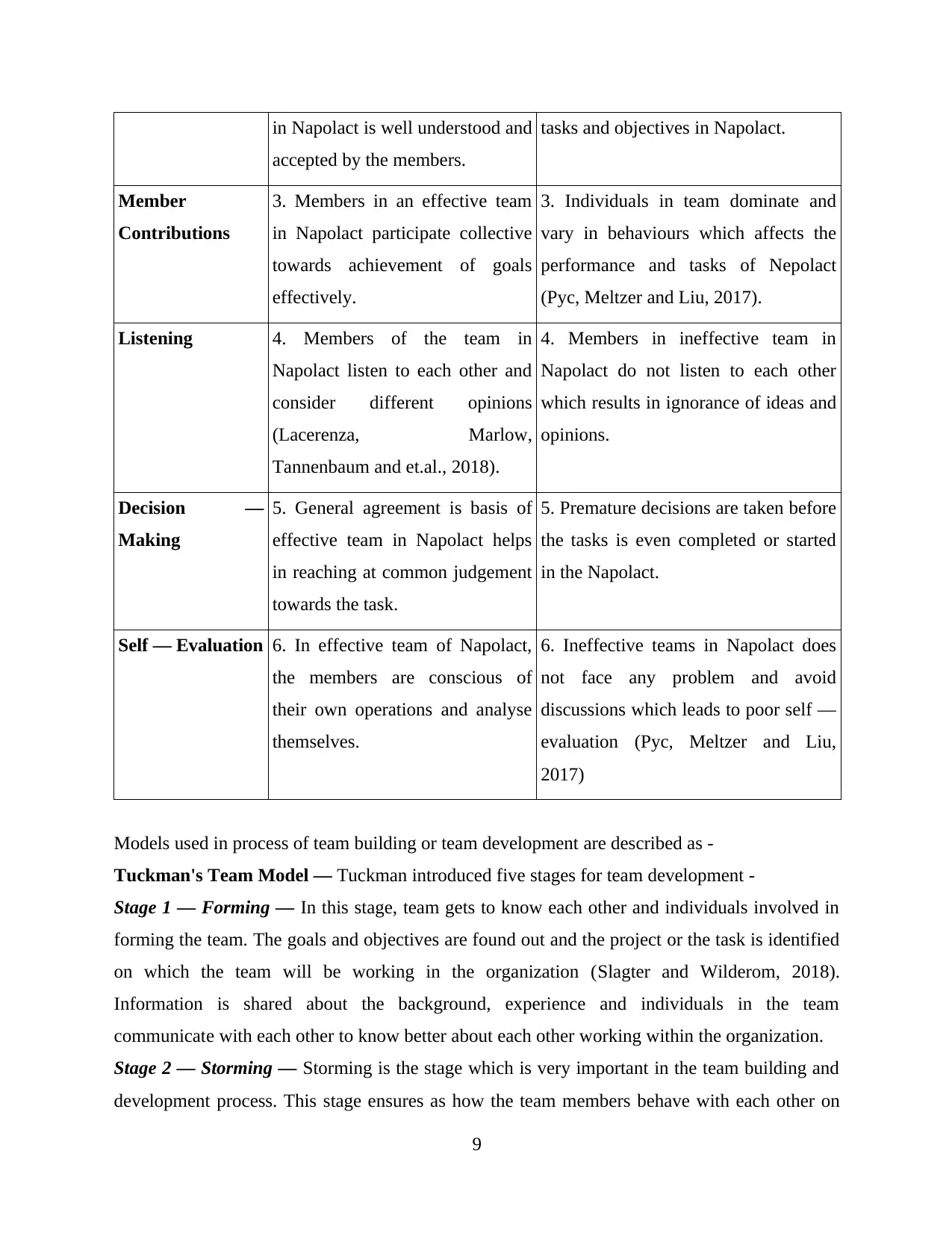
in Napolact is well understood and
accepted by the members.
tasks and objectives in Napolact.
Member
Contributions
3. Members in an effective team
in Napolact participate collective
towards achievement of goals
effectively.
3. Individuals in team dominate and
vary in behaviours which affects the
performance and tasks of Nepolact
(Pyc, Meltzer and Liu, 2017).
Listening 4. Members of the team in
Napolact listen to each other and
consider different opinions
(Lacerenza, Marlow,
Tannenbaum and et.al., 2018).
4. Members in ineffective team in
Napolact do not listen to each other
which results in ignorance of ideas and
opinions.
Decision —
Making
5. General agreement is basis of
effective team in Napolact helps
in reaching at common judgement
towards the task.
5. Premature decisions are taken before
the tasks is even completed or started
in the Napolact.
Self — Evaluation 6. In effective team of Napolact,
the members are conscious of
their own operations and analyse
themselves.
6. Ineffective teams in Napolact does
not face any problem and avoid
discussions which leads to poor self —
evaluation (Pyc, Meltzer and Liu,
2017)
Models used in process of team building or team development are described as -
Tuckman's Team Model — Tuckman introduced five stages for team development -
Stage 1 — Forming — In this stage, team gets to know each other and individuals involved in
forming the team. The goals and objectives are found out and the project or the task is identified
on which the team will be working in the organization (Slagter and Wilderom, 2018).
Information is shared about the background, experience and individuals in the team
communicate with each other to know better about each other working within the organization.
Stage 2 — Storming — Storming is the stage which is very important in the team building and
development process. This stage ensures as how the team members behave with each other on
9
accepted by the members.
tasks and objectives in Napolact.
Member
Contributions
3. Members in an effective team
in Napolact participate collective
towards achievement of goals
effectively.
3. Individuals in team dominate and
vary in behaviours which affects the
performance and tasks of Nepolact
(Pyc, Meltzer and Liu, 2017).
Listening 4. Members of the team in
Napolact listen to each other and
consider different opinions
(Lacerenza, Marlow,
Tannenbaum and et.al., 2018).
4. Members in ineffective team in
Napolact do not listen to each other
which results in ignorance of ideas and
opinions.
Decision —
Making
5. General agreement is basis of
effective team in Napolact helps
in reaching at common judgement
towards the task.
5. Premature decisions are taken before
the tasks is even completed or started
in the Napolact.
Self — Evaluation 6. In effective team of Napolact,
the members are conscious of
their own operations and analyse
themselves.
6. Ineffective teams in Napolact does
not face any problem and avoid
discussions which leads to poor self —
evaluation (Pyc, Meltzer and Liu,
2017)
Models used in process of team building or team development are described as -
Tuckman's Team Model — Tuckman introduced five stages for team development -
Stage 1 — Forming — In this stage, team gets to know each other and individuals involved in
forming the team. The goals and objectives are found out and the project or the task is identified
on which the team will be working in the organization (Slagter and Wilderom, 2018).
Information is shared about the background, experience and individuals in the team
communicate with each other to know better about each other working within the organization.
Stage 2 — Storming — Storming is the stage which is very important in the team building and
development process. This stage ensures as how the team members behave with each other on
9
⊘ This is a preview!⊘
Do you want full access?
Subscribe today to unlock all pages.

Trusted by 1+ million students worldwide
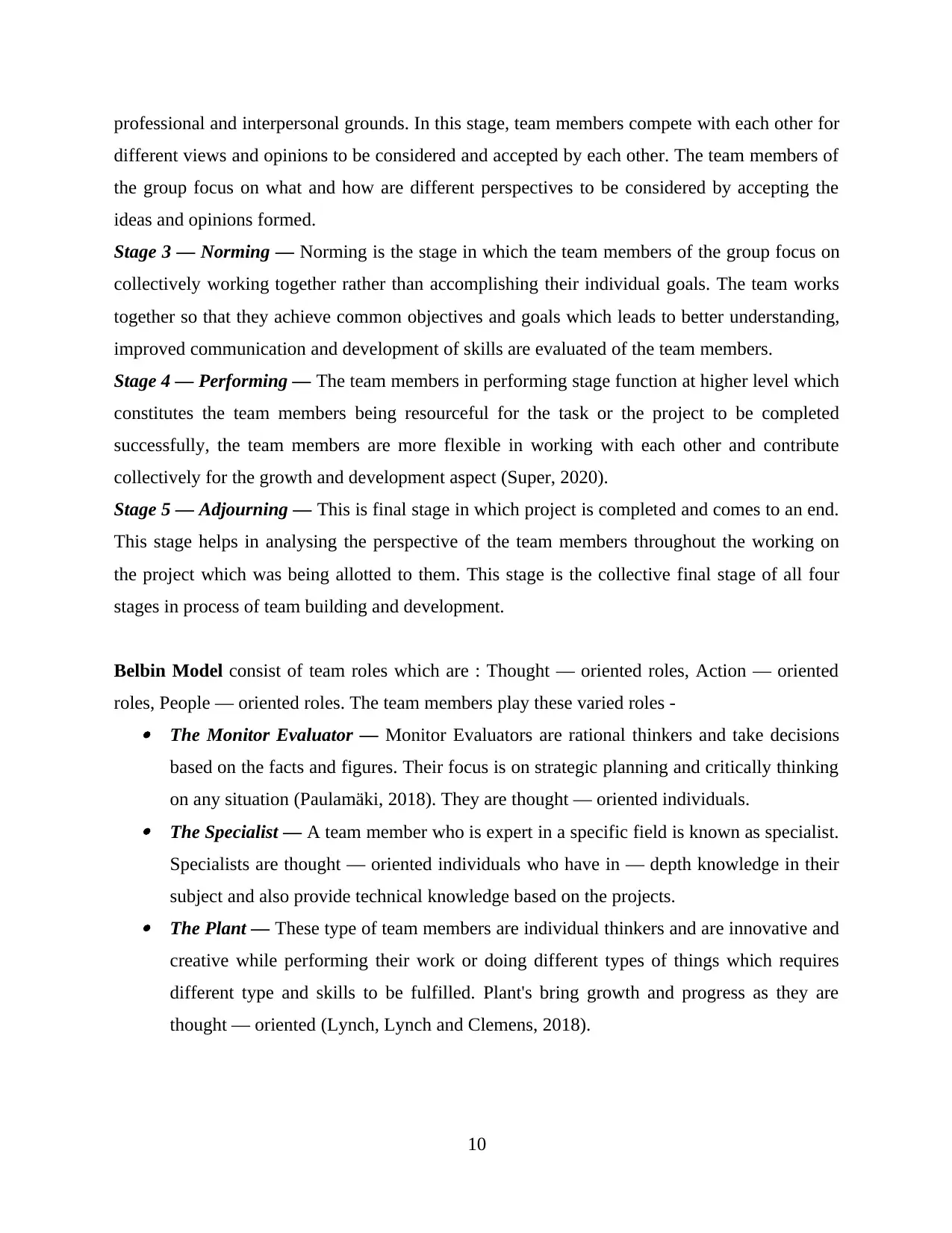
professional and interpersonal grounds. In this stage, team members compete with each other for
different views and opinions to be considered and accepted by each other. The team members of
the group focus on what and how are different perspectives to be considered by accepting the
ideas and opinions formed.
Stage 3 — Norming — Norming is the stage in which the team members of the group focus on
collectively working together rather than accomplishing their individual goals. The team works
together so that they achieve common objectives and goals which leads to better understanding,
improved communication and development of skills are evaluated of the team members.
Stage 4 — Performing — The team members in performing stage function at higher level which
constitutes the team members being resourceful for the task or the project to be completed
successfully, the team members are more flexible in working with each other and contribute
collectively for the growth and development aspect (Super, 2020).
Stage 5 — Adjourning — This is final stage in which project is completed and comes to an end.
This stage helps in analysing the perspective of the team members throughout the working on
the project which was being allotted to them. This stage is the collective final stage of all four
stages in process of team building and development.
Belbin Model consist of team roles which are : Thought — oriented roles, Action — oriented
roles, People — oriented roles. The team members play these varied roles - The Monitor Evaluator — Monitor Evaluators are rational thinkers and take decisions
based on the facts and figures. Their focus is on strategic planning and critically thinking
on any situation (Paulamäki, 2018). They are thought — oriented individuals. The Specialist — A team member who is expert in a specific field is known as specialist.
Specialists are thought — oriented individuals who have in — depth knowledge in their
subject and also provide technical knowledge based on the projects. The Plant — These type of team members are individual thinkers and are innovative and
creative while performing their work or doing different types of things which requires
different type and skills to be fulfilled. Plant's bring growth and progress as they are
thought — oriented (Lynch, Lynch and Clemens, 2018).
10
different views and opinions to be considered and accepted by each other. The team members of
the group focus on what and how are different perspectives to be considered by accepting the
ideas and opinions formed.
Stage 3 — Norming — Norming is the stage in which the team members of the group focus on
collectively working together rather than accomplishing their individual goals. The team works
together so that they achieve common objectives and goals which leads to better understanding,
improved communication and development of skills are evaluated of the team members.
Stage 4 — Performing — The team members in performing stage function at higher level which
constitutes the team members being resourceful for the task or the project to be completed
successfully, the team members are more flexible in working with each other and contribute
collectively for the growth and development aspect (Super, 2020).
Stage 5 — Adjourning — This is final stage in which project is completed and comes to an end.
This stage helps in analysing the perspective of the team members throughout the working on
the project which was being allotted to them. This stage is the collective final stage of all four
stages in process of team building and development.
Belbin Model consist of team roles which are : Thought — oriented roles, Action — oriented
roles, People — oriented roles. The team members play these varied roles - The Monitor Evaluator — Monitor Evaluators are rational thinkers and take decisions
based on the facts and figures. Their focus is on strategic planning and critically thinking
on any situation (Paulamäki, 2018). They are thought — oriented individuals. The Specialist — A team member who is expert in a specific field is known as specialist.
Specialists are thought — oriented individuals who have in — depth knowledge in their
subject and also provide technical knowledge based on the projects. The Plant — These type of team members are individual thinkers and are innovative and
creative while performing their work or doing different types of things which requires
different type and skills to be fulfilled. Plant's bring growth and progress as they are
thought — oriented (Lynch, Lynch and Clemens, 2018).
10
Paraphrase This Document
Need a fresh take? Get an instant paraphrase of this document with our AI Paraphraser
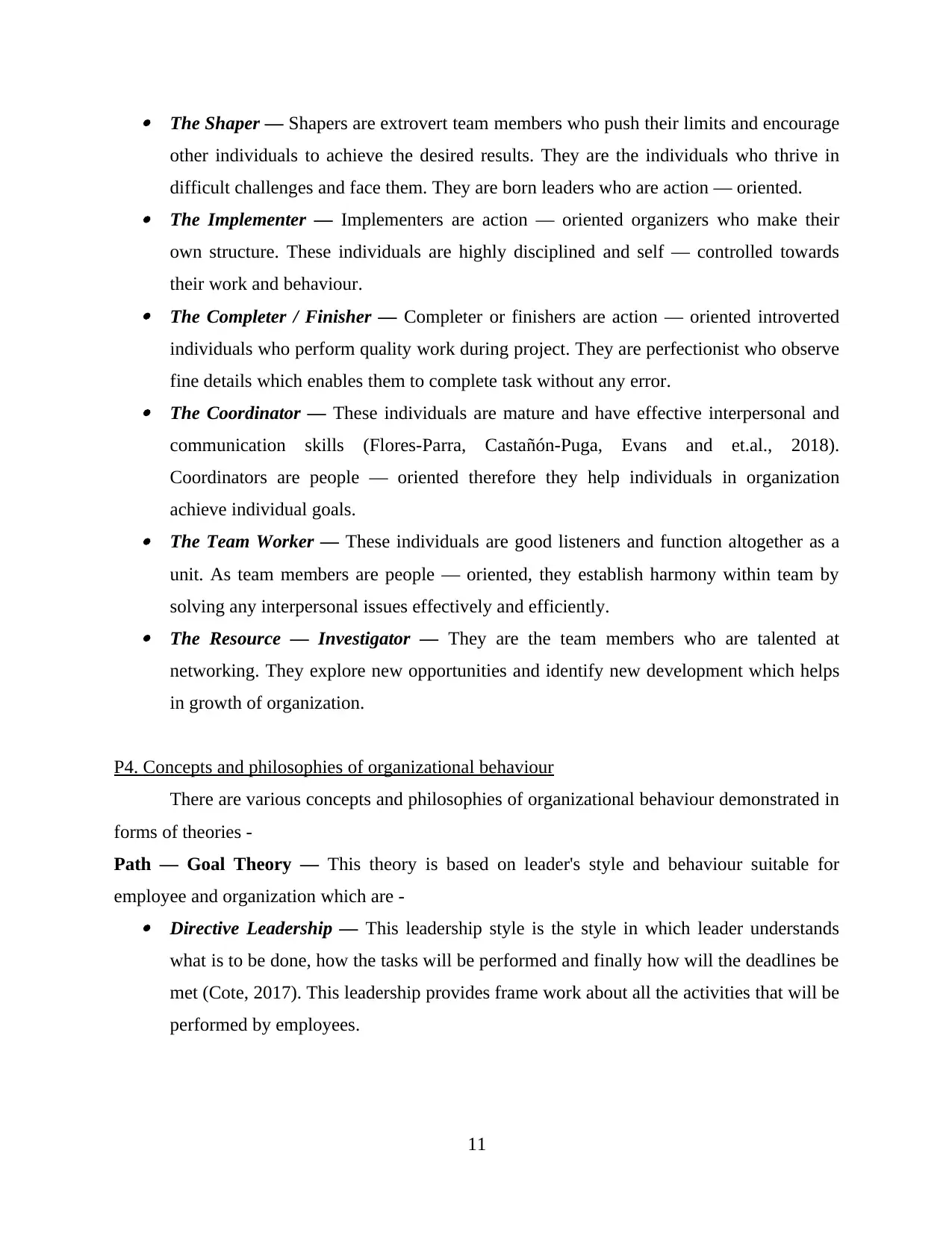
The Shaper — Shapers are extrovert team members who push their limits and encourage
other individuals to achieve the desired results. They are the individuals who thrive in
difficult challenges and face them. They are born leaders who are action — oriented. The Implementer — Implementers are action — oriented organizers who make their
own structure. These individuals are highly disciplined and self — controlled towards
their work and behaviour. The Completer / Finisher — Completer or finishers are action — oriented introverted
individuals who perform quality work during project. They are perfectionist who observe
fine details which enables them to complete task without any error. The Coordinator — These individuals are mature and have effective interpersonal and
communication skills (Flores-Parra, Castañón-Puga, Evans and et.al., 2018).
Coordinators are people — oriented therefore they help individuals in organization
achieve individual goals. The Team Worker — These individuals are good listeners and function altogether as a
unit. As team members are people — oriented, they establish harmony within team by
solving any interpersonal issues effectively and efficiently. The Resource — Investigator — They are the team members who are talented at
networking. They explore new opportunities and identify new development which helps
in growth of organization.
P4. Concepts and philosophies of organizational behaviour
There are various concepts and philosophies of organizational behaviour demonstrated in
forms of theories -
Path — Goal Theory — This theory is based on leader's style and behaviour suitable for
employee and organization which are - Directive Leadership — This leadership style is the style in which leader understands
what is to be done, how the tasks will be performed and finally how will the deadlines be
met (Cote, 2017). This leadership provides frame work about all the activities that will be
performed by employees.
11
other individuals to achieve the desired results. They are the individuals who thrive in
difficult challenges and face them. They are born leaders who are action — oriented. The Implementer — Implementers are action — oriented organizers who make their
own structure. These individuals are highly disciplined and self — controlled towards
their work and behaviour. The Completer / Finisher — Completer or finishers are action — oriented introverted
individuals who perform quality work during project. They are perfectionist who observe
fine details which enables them to complete task without any error. The Coordinator — These individuals are mature and have effective interpersonal and
communication skills (Flores-Parra, Castañón-Puga, Evans and et.al., 2018).
Coordinators are people — oriented therefore they help individuals in organization
achieve individual goals. The Team Worker — These individuals are good listeners and function altogether as a
unit. As team members are people — oriented, they establish harmony within team by
solving any interpersonal issues effectively and efficiently. The Resource — Investigator — They are the team members who are talented at
networking. They explore new opportunities and identify new development which helps
in growth of organization.
P4. Concepts and philosophies of organizational behaviour
There are various concepts and philosophies of organizational behaviour demonstrated in
forms of theories -
Path — Goal Theory — This theory is based on leader's style and behaviour suitable for
employee and organization which are - Directive Leadership — This leadership style is the style in which leader understands
what is to be done, how the tasks will be performed and finally how will the deadlines be
met (Cote, 2017). This leadership provides frame work about all the activities that will be
performed by employees.
11
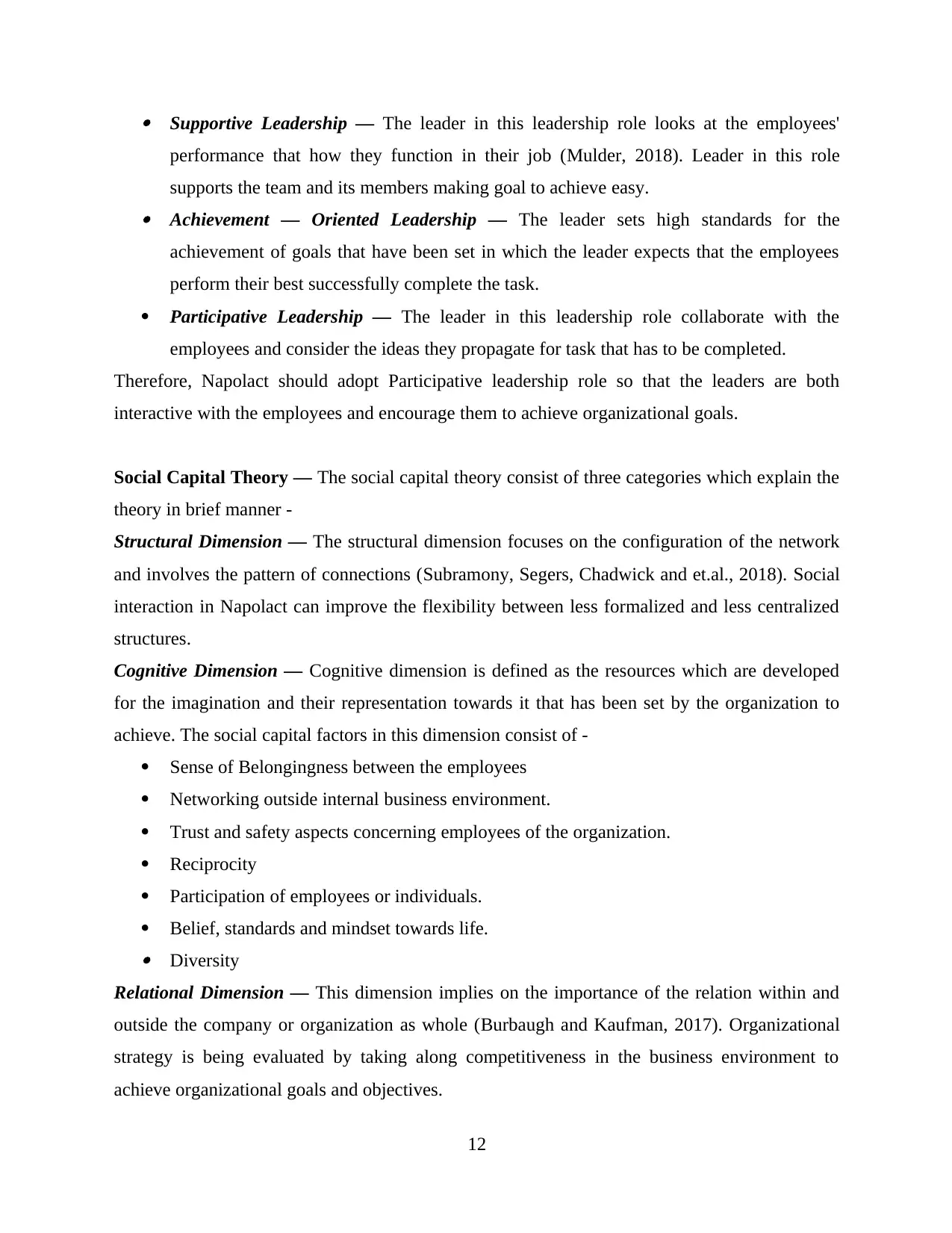
Supportive Leadership — The leader in this leadership role looks at the employees'
performance that how they function in their job (Mulder, 2018). Leader in this role
supports the team and its members making goal to achieve easy. Achievement — Oriented Leadership — The leader sets high standards for the
achievement of goals that have been set in which the leader expects that the employees
perform their best successfully complete the task.
Participative Leadership — The leader in this leadership role collaborate with the
employees and consider the ideas they propagate for task that has to be completed.
Therefore, Napolact should adopt Participative leadership role so that the leaders are both
interactive with the employees and encourage them to achieve organizational goals.
Social Capital Theory — The social capital theory consist of three categories which explain the
theory in brief manner -
Structural Dimension — The structural dimension focuses on the configuration of the network
and involves the pattern of connections (Subramony, Segers, Chadwick and et.al., 2018). Social
interaction in Napolact can improve the flexibility between less formalized and less centralized
structures.
Cognitive Dimension — Cognitive dimension is defined as the resources which are developed
for the imagination and their representation towards it that has been set by the organization to
achieve. The social capital factors in this dimension consist of -
Sense of Belongingness between the employees
Networking outside internal business environment.
Trust and safety aspects concerning employees of the organization.
Reciprocity
Participation of employees or individuals.
Belief, standards and mindset towards life. Diversity
Relational Dimension — This dimension implies on the importance of the relation within and
outside the company or organization as whole (Burbaugh and Kaufman, 2017). Organizational
strategy is being evaluated by taking along competitiveness in the business environment to
achieve organizational goals and objectives.
12
performance that how they function in their job (Mulder, 2018). Leader in this role
supports the team and its members making goal to achieve easy. Achievement — Oriented Leadership — The leader sets high standards for the
achievement of goals that have been set in which the leader expects that the employees
perform their best successfully complete the task.
Participative Leadership — The leader in this leadership role collaborate with the
employees and consider the ideas they propagate for task that has to be completed.
Therefore, Napolact should adopt Participative leadership role so that the leaders are both
interactive with the employees and encourage them to achieve organizational goals.
Social Capital Theory — The social capital theory consist of three categories which explain the
theory in brief manner -
Structural Dimension — The structural dimension focuses on the configuration of the network
and involves the pattern of connections (Subramony, Segers, Chadwick and et.al., 2018). Social
interaction in Napolact can improve the flexibility between less formalized and less centralized
structures.
Cognitive Dimension — Cognitive dimension is defined as the resources which are developed
for the imagination and their representation towards it that has been set by the organization to
achieve. The social capital factors in this dimension consist of -
Sense of Belongingness between the employees
Networking outside internal business environment.
Trust and safety aspects concerning employees of the organization.
Reciprocity
Participation of employees or individuals.
Belief, standards and mindset towards life. Diversity
Relational Dimension — This dimension implies on the importance of the relation within and
outside the company or organization as whole (Burbaugh and Kaufman, 2017). Organizational
strategy is being evaluated by taking along competitiveness in the business environment to
achieve organizational goals and objectives.
12
⊘ This is a preview!⊘
Do you want full access?
Subscribe today to unlock all pages.

Trusted by 1+ million students worldwide
1 out of 18
Related Documents
Your All-in-One AI-Powered Toolkit for Academic Success.
+13062052269
info@desklib.com
Available 24*7 on WhatsApp / Email
![[object Object]](/_next/static/media/star-bottom.7253800d.svg)
Unlock your academic potential
Copyright © 2020–2025 A2Z Services. All Rights Reserved. Developed and managed by ZUCOL.




